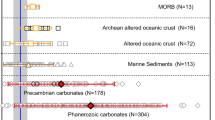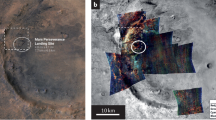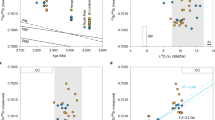Abstract
Mineral abundances derived from the analysis of remotely sensed thermal emission data from Mars have been interpreted to indicate that the surface is composed of basalt (Surface Type 1) and andesite (Surface Type 2)1. The global distribution of these rock types is divided roughly along the planetary dichotomy which separates ancient, heavily cratered crust in the southern hemisphere (basalt) from younger lowland plains in the north (andesite)1. But the existence of such a large volume of andesite is difficult to reconcile with our present understanding of the geological evolution of Mars. Here we reinterpret martian surface rock lithologies using mineral abundances from previous work1 and new mineralogies derived from a spectral end-member set representing minerals common in unaltered and low-temperature aqueously altered basalts. Our results continue to indicate the dominance of unaltered basalt in the southern highlands, but reveal that the northern lowlands can be interpreted as weathered basalt as an alternative to andesite. The coincidence between locations of such altered basalt and a suggested northern ocean basin implies that lowland plains material may be composed of basalts weathered under submarine conditions or weathered basaltic sediments transported into this depocentre.
This is a preview of subscription content, access via your institution
Access options
Subscribe to this journal
Receive 51 print issues and online access
$199.00 per year
only $3.90 per issue
Buy this article
- Purchase on Springer Link
- Instant access to full article PDF
Prices may be subject to local taxes which are calculated during checkout



Similar content being viewed by others
References
Bandfield, J. L., Hamilton, V. E. & Christensen, P. R. A global view of martian surface compositions from MGS-TES. Science 287, 1626–1630 (2000)
Christensen, P. R. et al. Identification of a basaltic component on the martian surface from Thermal Emission Spectrometer data. J. Geophys. Res. 105, 9609–9621 (2000)
Mustard, J. F., Murchie, S., Erard, S. & Sunshine, J. M. In situ compositions of martian volcanics: Implications for the mantle. J. Geophys. Res. 102, 25605–25615 (1997)
Rieder, R. et al. The chemical composition of martian soils and rocks returned by the mobile alpha proton X-ray spectrometer: Preliminary results from the X-ray mode. Science 278, 1771–1774 (1997)
Wyatt, M. B. et al. Analysis of terrestrial and martian volcanic compositions using thermal emission spectroscopy: I. Determination of mineralogy, chemistry, and classification strategies. J. Geophys. Res. 106, 14711–14732 (2001)
Hamilton, V. E. et al. Analysis of terrestrial and martian volcanic compositions using thermal emission spectroscopy: II. Application to martian surface spectra from the Mars Global Surveyor Thermal Emission Spectrometer. J. Geophys. Res. 106, 14733–14746 (2001)
McSween, H. Y. Jr et al. Chemical, multispectral, and textural constraints on the composition and origin of rocks at the Mars Pathfinder landing site. J. Geophys. Res. 104, 8679–8715 (1999)
McSween, H. Y. Jr et al. Geochemical evidence for magmatic water within Mars from pyroxenes in the Shergotty meteorite. Nature 409, 487–490 (2001)
Noble, S. K. & Pieters, C. M. Type 2 terraine: compositional constraints on the martian lowlands. Lunar Planet. Sci. Conf. XXXII, [online] CD 1230 (2001)
Minitti, M. E., Rutherford, M. J. & Mustard, J. F. The effects of oxidation on spectra of SNC-like basalts: Application to Mars remote sensing. Lunar Planet. Sci. Conf. XXXI, [online] CD 1282 (2000)
Head, J. W. et al. Possible ancient oceans on Mars; evidence from Mars Orbiter laser altimeter data. Science 286, 2134–2137 (1999)
Christensen, P. R. et al. A thermal emission spectral library of rock forming minerals. J. Geophys. Res. 105, 9735–9739 (2000)
Thompson, G. in Hydrothermal Processes at Seafloor Spreading Centers (eds Rona, P. A., Bostrom, K., Laubier, L. & Smith, K. L. Jr) 225–278 (Plenum, New York, 1983)
Smith, D. E. et al. The global topography of Mars and implications for surface evolution. Science 284, 1495–1503 (1999)
Parker, T. J. et al. Transitional morphology in the west Deuteronilus Mensae region of Mars: implications for modification of the lowland/upland boundary. Icarus 82, 111–145 (1989)
Murchie, S., Kirkland, L., Erard, S., Mustard, J. & Robinson, M. Near-infrared spectral variations of martian surface materials from ISM imaging spectrometer data. Icarus 147, 444–471 (2000)
Murchie, S. et al. Spatial variations in the spectral properties of bright regions on Mars. Icarus 105, 454–468 (1993)
Merényi, E., Singer, R. B. & Miller, J. S. Mapping of spectral variations on the surface of Mars from high spectral resolution telescopic images. Icarus 124, 280–295 (1996)
Frey, H. V. et al. A very large population of likely buried impact basins in the northern lowlands of Mars revealed by MOLA data. Lunar Planet. Sci. Conf. XXXII, [on line] CD 1680 (2001)
McSween, H. Y. Jr & Keil, K. Mixing relationships in the martian regolith and the composition of globally homogenous dust. Geochim. Cosmochim. Acta 64, 2155–2166 (2000)
Acknowledgements
We thank J. Bandfield, J. Moersch, T. Hare, J. Mustard, R. Clark, V. Hamilton and P. Christensen for discussions of the results presented here.
Author information
Authors and Affiliations
Corresponding author
Ethics declarations
Competing interests
The authors declare that they have no competing financial interests.
Supplementary information
Rights and permissions
About this article
Cite this article
Wyatt, M., McSween, H. Spectral evidence for weathered basalt as an alternative to andesite in the northern lowlands of Mars. Nature 417, 263–266 (2002). https://doi.org/10.1038/417263a
Received:
Accepted:
Issue Date:
DOI: https://doi.org/10.1038/417263a
This article is cited by
-
Development and Testing of the MarSCoDe LIBS Calibration Target in China’s Tianwen-1 Mars Mission
Space Science Reviews (2023)
-
Early crustal processes revealed by the ejection site of the oldest martian meteorite
Nature Communications (2022)
-
Image Simulation and Assessment of the Colour and Spatial Capabilities of the Colour and Stereo Surface Imaging System (CaSSIS) on the ExoMars Trace Gas Orbiter
Space Science Reviews (2018)
-
Prolonged magmatic activity on Mars inferred from the detection of felsic rocks
Nature Geoscience (2013)
-
Long-Term Evolution of the Martian Crust-Mantle System
Space Science Reviews (2013)
Comments
By submitting a comment you agree to abide by our Terms and Community Guidelines. If you find something abusive or that does not comply with our terms or guidelines please flag it as inappropriate.



